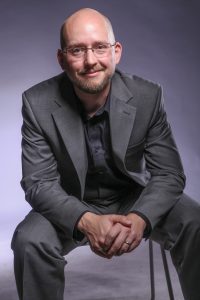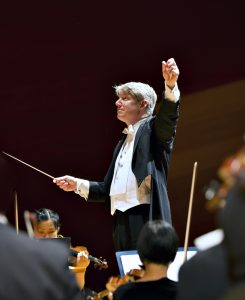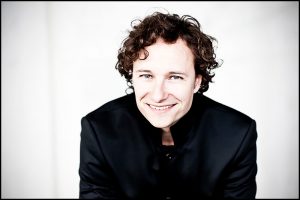“The last rail is laid. The last spike is driven. The Pacific Railroad is completed.” Thus began the report that was telegraphed to the Associated Press on May 10th, 1869, announcing the completion of one of the great engineering feats of the 20th century: The North American Continental Divide had been spanned by rail, and the once-perilous five-month trip from the Atlantic to the Pacific could now be done in five days.
To this day, the completion of the First Transcontinental Railroad (1,912 miles of rail, from Omaha to Sacramento) remains one of the least-recognized milestones in the expansion of the United States into a nation. And alhough Kansas City was not on that initial line, it would soon become an essential hub for rail lines running in all directions.

Composer Daniel Kellogg
It seemed appropriate, then, that the Kansas City Symphony should begin its 2019-2020 season with a new work commemorating this critical moment in our history, exactly 150 years after the completion of the First Transcontinental Railroad.
The Golden Spike, commissioned for the Symphony’s Opening Subscription Weekend (October 4th through the 6th), takes its name from the actual stakes (there were four) that were driven into the Utah ground on that day in 1869: by California Governor Leland Stanford (titular head of the Central Pacific Railroad) and Thomas C. Durant of the Union Pacific.
The event, which took place on a desolate plain high in the Promontory Mountains, was marked by nationwide celebrations and was communicated to every telegraph station in the country.
“It’s a little bit difficult to fathom what this change meant to our country,” said Daniel Kellogg, the composer who has created the new piece, adding that there is indeed a romantic aspect to the “magical taming of the land” that this moment represented. But the Connecticut-born composer, whose Water Music was one of the first new works the Symphony performed during the inauguration of the Kauffman Center, does not shy from some of the darker aspects of this event.

Michael Stern conducts the program / Photo by Todd Rosenberg
Yes, it’s true, as Daniel writes in his program notes, that the new rail line “led to the growth and development of the ‘great American desert’ and the fertile agricultural industries of the west coast,” and to vast amounts of new east-west trade. Plus for better or worse, Daniel said, rail would become a key to America’s post-Civil War commercial development, its ability to “mobilize its natural resources and move increasingly toward being a superpower.”
At the same time it “provided the unfortunate means of subduing the beleaguered native Americans of the western plains and mountains.” And it spelled death for hundreds of workers, many of them immigrants, who weathered long days in horrible conditions for meager pay.
“ ‘Manifest Destiny’ was of course the driving the idea behind this,” he said, adding that the piece is both “an elegy for what we’ve lost and what has changed, and the terrible things that were done toward fulfilling this vision.”
All of this is represented in The Golden Spike, whose three movements reflect, with considerable nuance, the pros and the cons of this undertaking.
“Black Powder and Hell on Wheels” is a depiction both of the primitive explosives used in the rail-building process and of the seedy shantytowns that sprang up along the route.

Pianist Martin Helmchen also performs / Photo by Giorgia Bertazzi
“Promontory” is about sadness and loss, Daniel said: “the loss of that openness, that wilderness, that innocence … and the decimation of the Native American tribes.” The composer, who until recently lived in Colorado, put in quite a bit of travel toward researching the piece. Although Promontory is the site of a historic site nowadays, it’s actually a fairly desolate plase, he said: “It’s dry, it’s arid, it’s dirt. … It really is a sort of no-man’s land. So this movement is really an elegy.”
“Manifest Destiny,” the finale, touches upon the controversial idea that “it was the ‘inevitable future’ of America to settle this land and to move West,” Daniel said. Thus while the second movement is an elegy, the finale is more of a tribute to “the grand fulfilling of a vision, and to growth and prosperity.”
News reports of the day tell of canons and church bells and all manner of noise, commemorating the moment from coast to coast. Daniel’s finale tries to convey some of the “cacophony of celebrations going on,” he said. “I imagined this big locomotive, pushing us onward into our future.”
—By Paul Horsley
Finlandia and Schumann’s Piano Concerto features guest pianist Martin Helmchen and also includes music of Sibelius (Finlandia) and Smetana (Blaník). For tickets call 816-471-0400 or go to kcsymphony.org.
To reach Paul Horsley, performing arts editor; send an email to paul@kcindependent.com or find him on Facebook or Twitter (@phorsleycritic).
